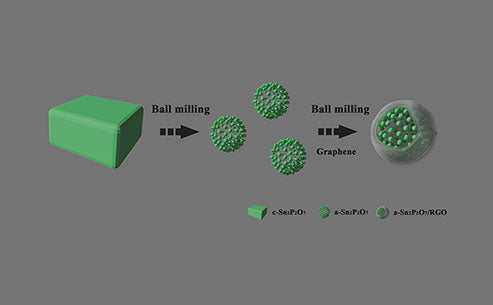
The research of tin-based composite oxide (TCO) started from Fuji Company of Japan. Researchers found that amorphous tin-based composite oxide has better cycle life and higher reversible specific capacity. This result attracted a lot of attention, and subsequently, many studies on this aspect have been reported in succession. Tin-based composite oxides can solve the problems of large volume changes of Sn oxide anode materials, high first charge and discharge irreversible capacity, and unsatisfactory cycle performance to a certain extent. The method is to add some metal or non-metal oxides, such as B, Al, Si, Ge, P, Ti, Mn, Fe and other element oxides to the Sn oxide, and then obtain it through heat treatment.
The tin-based composite oxide has an amorphous structure, and the addition of other oxides makes the mixture form an amorphous glass body, so it can be represented by the general formula SnMxOy (x≥1), where M represents a group of metal or non-metal elements (can be 1-3) that form the glass body, usually oxides such as B, P, and Al. Structurally, the tin-based composite oxide is composed of Sn-O bonds in the active center and a random grid structure around it. The random grid is composed of added metal or non-metal oxides, which isolate the active centers from each other. Therefore, Li can be stored effectively, and the capacity is related to the active center. The reversible specific capacity of tin-based composite oxide can reach 600mA·h/g, and the volume specific capacity is greater than 2200mA·h/cm3, which is more than twice that of the carbon anode material (amorphous carbon and graphitized carbon are less than 1200mA·h/cm3 and 500mA·h/cm3, respectively) with the highest capacity.
For the lithium storage mechanism of tin-based composite oxides, there are two types: one is ionic type, and the other is alloy type. Ionic mechanism believes that Li and TCO electrode intercalation reaction, Li exists in the form of ions in the product. Taking SnB0.5P0.5O3 as an example, its mechanism can be expressed as:

The alloying mechanism of TCO is similar to that of tin oxide alloy, and it is also a two-step reaction mechanism. First, TCO reacts with Li to produce Li2O, other oxides, and metal tin, and then tin reacts with Li to produce lithium tin alloy. Taking Sn2BPO6 as an example, its mechanism can be expressed as:

Through the study of the nuclear magnetic resonance spectrum of Li, it is believed that the lithium in the TCO electrode exists in the form of ions rather than the state of metal. However, both In-situ XRD spectroscopy and Raman spectroscopy confirmed the existence of Sn clusters (Figure 1). At present, the conclusions of most researches mostly support the alloy type mechanism.

Figure 1 - 7Li NMR spectrum after TCO lithium insertion
The amorphous structure of the tin-based composite oxide hardly changes its volume before and after charging and discharging, the structure is stable, and it is not easy to be damaged, so the cycle performance of the tin-based composite oxide is relatively good. Moreover, compared with the crystalline Sn oxide, the structure of the tin-based composite oxide facilitates the reversible insertion and extraction of lithium, and an improved lithium diffusion coefficient.
The preparation method of tin-based composite oxide is similar to that of simple tin oxide, and it can also be prepared by high-temperature solid phase method, mechanochemical activation method, radio frequency sputtering method, electrostatic spray deposition method, co-precipitation method and sol-gel method. For example, SnO is mixed with B, P, Al oxides, and Sn1.0B0.56P0.4Al0.42O3.47 is prepared by high-temperature solid-phase method, and the material has an amorphous structure; Sn1.0B0.56P0.4Al0.42O3.47 is prepared by high-temperature sintering method, charged and discharged at a constant current of 1mA at 0~1.2V. During the first cycle, the charge capacity is 1030mA·h/g, the discharge capacity is 650mA·h/g, and the capacity loss is 37%; however, in the subsequent cycles, the Coulombic efficiency reached nearly 100%; elements such as P and Mn were added to SnO to prepare SnMm0.5PO4 material at high temperature (700°C), and its irreversible capacity was low.
The ZnO-SnO2 system was synthesized by ball milling ZnO and SnO2. The results showed that when the ZnO content is low, the cycle performance can be effectively improved. When the ZnO content is high, the cycle performance becomes worse.
Using radio frequency sputtering, using SnB0.6 P0.4O2.9 as the emission source, and using metal Au and metal Cr as the bottom layer, respectively, tin-based composite oxides were prepared in an argon plasma atmosphere. Experiments show that after 20 cycles, a reversible specific capacity of 550mA·h/g can still be obtained.
The tin oxide film is obtained by electrostatic spray deposition at 400°C, and then calcined at 500°C in an air atmosphere to obtain amorphous tin dioxide. Discharging at a current of 0.2mA/cm2 under a voltage of 0~1.0V, a reversible specific capacity of 600mA·h/g can still be obtained after 100 cycles. In addition, when charging and discharging with a current of up to 2mA/cm2, a reversible specific capacity of 500mA·h/g was also obtained, showing the material's good high-current charging and discharging performance.
Co-precipitation method and sol-gel method were used to prepare tin-based composite oxides. The tin-based composite oxide electrode material prepared by the two methods has better cycle performance than the tin oxide electrode material. The sol-gel method has better cycle performance due to the more uniform composition. Two tin-based composite oxide powders, SnSbO2.5 and SnGeO3, were prepared by co-precipitation. Their reversible capacities were 1200mA·h/g and 750mA·h/g, which were much higher than the reversible capacities of carbon materials, and its lithium insertion potential and lithium removal potential are both around 0.2V and 0.5V, respectively.

Bulk tin-based composite oxide (TCO) active material (left)















